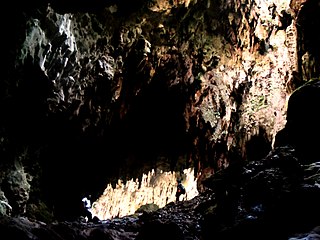Callao cave
| Callao cave
|
||
|---|---|---|
|
Fifth room of the cave |
||
| Location: | Cagayan Valley , Philippines | |
|
Geographic location: |
17 ° 42 '11.7 " N , 121 ° 49' 25.5" E | |
|
|
||
| Type: | Limestone cave | |
The Callao Cave is a limestone cave in the municipality of Peñablanca , Cagayan to the Philippines .
location
The Callao Cave is located in the north of the island of Luzon , about 24 kilometers from Tuguegarao City .
National park
Callao Cave is part of Callao Cave National Park , which was established in 1935 as one of the first national parks in the country. The 192 hectare site includes the Callao Cave and more than 300 other caves, of which the Callao Cave and the adjoining Sierra Cave are the best known due to their easy accessibility.
construction
The Callao Cave is characterized in particular by its seven halls, the ceiling of which reaches just below the surface of the earth. A special feature of the Callao Cave is that these huge halls are all illuminated by daylight, as small incisions in the cave ceiling let light into the interior.
The Callao Cave originally had nine such halls, but an earthquake in 1980 caused two of these halls to collapse, leaving the seven halls known today.
Visitors
Callao Cave is easy to explore and visitors can enter Callao Cave without a guide or instruction. The cave is known nationwide, so that almost all visitors to the cave are Filipinos. One of the attractions of the cave is a chapel , which was established by the local population in one of the halls.
Fossil finds
The Callao Cave is a well known fossil deposit . The discovery of a small metatarsal bone discovered in 2007 , which dates to an age of around 67,000 years and was initially interpreted as evidence of an early settlement of the region by anatomically modern humans ( Homo sapiens ), received international attention . This dating and its assignment to anatomically modern humans meant that the bone find was the oldest evidence of the presence of Homo sapiens east of the Wallace line , which advanced the spread of humans in this region by more than 10,000 years and all previous archaeological and genetic ones Knowledge contradicted; the reliability of the dating was therefore controversial. In 2011, two unusually small, medium-sized phalanges were discovered in the same layer and attributed to Homo sapiens : one finger and one toe . In April 2019, these three fossils, along with ten other isolated tooth and bone finds, were attributed to an independent, presumably small species of the genus Homo , called Homo luzonensis .
Individual evidence
- ↑ Visitmyphilippines.com: Department of Tourism - The Philippines Ultimate Travel Guide for Tourist. Retrieved May 9, 2018 .
- ^ Cagayan and Its Over 300 Caves - Travel to the Philippines . In: Travel to the Philippines . December 6, 2011 ( traveltothephilippines.info [accessed May 9, 2018]).
- ↑ Bert Marco Schuldes, [email protected]: Philippines: The wonderful caves of Callao. Retrieved May 9, 2018 .
- ↑ Callao Cave: Travel Guide, How to Get There, Where to Stay and More! | Lakwatsero. Retrieved May 9, 2018 (American English).
- ^ Armand Salvador Mijares, Florent Détroit et al .: New evidence for a 67,000-year-old human presence at Callao Cave, Luzon, Philippines. In: Journal of Human Evolution. Volume 59, No. 1, 2010, pp. 123-132, doi: 10.1016 / j.jhevol.2010.04.008
- ↑ James F. O'Connell, Jim Allen, Martin AJ Williams et al .: When did Homo sapiens first reach Southeast Asia and Sahul? In: PNAS . Volume 115, No. 34, 2018, pp. 8482-8490, doi: 10.1073 / pnas.1808385115 .
- ↑ Florent Détroit et al .: "Small Size" in the Philippine Human Fossil Record: Is it Meaningful for a Better Understanding of the Evolutionary History of the Negritos? In: Human Biology. Volume 85, No. 1–3, 2013, pp. 45-66, doi: 10.3378 / 027.085.0303
- ^ Florent Détroit et al .: A new species of Homo from the Late Pleistocene of the Philippines. In: Nature . Volume 568, 2019, pp. 181-186, doi: 10.1038 / s41586-019-1067-9

